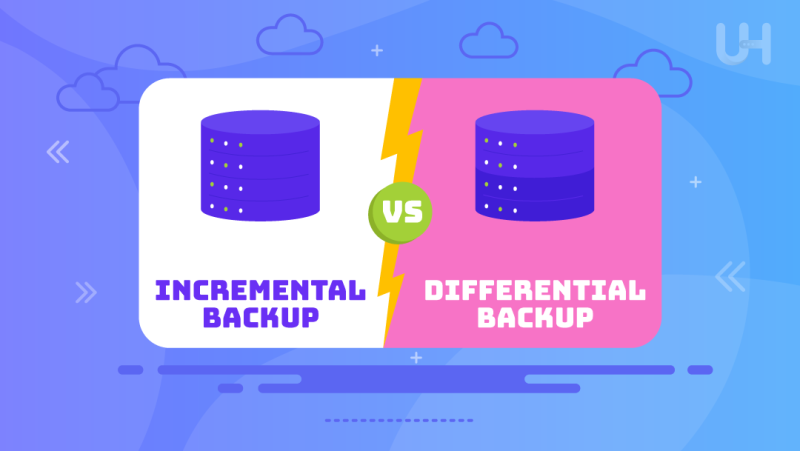Data backup serves two critical purposes: business continuity and data protection. Considering today’s digital scenario, there are two main alternative options for data backup: Incremental Backup vs Differential Backup. Both are designed to help meet different needs depending on the frequency of data change, recovery requirements, and storage constraints. Both options have advantages and disadvantages; hence, they suit certain situations based on organizational demand.
In this article, we will discuss Incremental Backup vs Differential Backup. The explanation below will present what features distinguish each backup type. Knowing these differences will become critical in choosing a backup strategy for your business’s best operation, recovery objectives, and storage capacities.
What is Incremental Backup?
An incremental backup includes only the changes made since the last full or incremental backup. It’s a strategy that efficiently and dependably works in regard to space, especially within environments where data changes a lot and normal backups have to be done in very short intervals. The data it contains is only what has changed, so the backup size is largely reduced. Once an initial full backup has been done, each progressive backup takes even less time. By utilizing a speedy VPS, users can enhance the performance of incremental backups, ensuring that data is backed up quickly and reliably without overloading network resources.
How Does It Work?
A full backup is a base for an incremental backup because it gives a reference point where all data within a system can be assumed to exist. Once this full backup is taken, the succeeding backups are considered to be incremental backups and capture only information that has been newly created or changed. For example, if a full WordPress website backup is executed on Monday, then Tuesday’s incremental backup contains changes that occurred after Monday’s backup. If an incremental backup was carried out on Wednesday, it contains only those changes after Tuesday’s backup, and so on.
This kind of backup structure uses a chain because each incremental still depends on the backup that came before it. Data loss or needs for recovery require access to and restoration of the entire chain of backups, starting from the full transfer all the way down to each successive incremental backup in that order. In other words, to get your complete data, there should be serious management of each backup down the chain.
Pros
- Efficient use of storage: Only changes since the last backup are saved.
- Shorter backup time: Smaller amounts of data need to be backed up after the initial full backup.
- Cost-effective: Reduces storage costs due to the smaller backup file sizes.
Cons
- Complex restoration process: All incremental backups in the chain must be restored in sequence.
- Higher dependency on the entire chain: If one incremental backup is corrupted, recovery could be incomplete.
- Potentially slower recovery time: Restoring data from multiple incremental backups can take longer than differential backups.
What is Differential Backup?
Differential backup can be explained as a backup method that relies on backing up everything that has changed since a full backup was performed rather than what changed since any type of backup was last performed. In other words, one differential backup will encompass all data modified since the last full backup, thus making the backup and recovery process much easier than the incremental backup.
How Does It Work?
Similar to their incremental cousins, differential backups take off from a full backup, which acts as a reference point. The key variance comes in at what differential backups capture as changed: all the data time since the last full backup, not since the last differential backup. Using the example above, if a full backup were taken on a Monday, Tuesday’s differential backup captures everything that has changed since Monday.
Wednesday’s differential backup will also contain all of the changes since Monday’s full backup, so it will grow in size each day until the next full backup. This results in larger backup sizes than those with incremental backups because each differential backup will include all the changes that have occurred since the full backup. Recoveries entail only the need for the last differential and full backup, hence faster and less complicated than an incremental recovery.
Pros
- Simpler recovery process: Only the latest differential and original full backup are needed.
- Reduced dependency on previous backups: No dependency on a chain of backups for recovery.
- Potentially faster recovery times: Fewer files to process during data restoration.
Cons
- Larger storage requirements: Differential backups accumulate changes and grow in size, using more storage over time.
- Longer backup times as backups grow: Each differential backup includes all changes since the last full backup, which can increase backup times.
- More costly over time: Higher storage demands can lead to increased costs.
Optimize Your Data Security Today!
Looking for a reliable way to protect your data? UltaHost’s NVMe VPS Hosting offers fast, secure backup solutions. Our services support both incremental and differential backups for easy data recovery.
Differential Backup vs Incremental Backup: Comparing Both Strategies
The choice between an Incremental Backup vs Differential Backup strategy will involve trade-offs: storage efficiency with recovery complexity. Both methods serve different needs, and understanding those needs will help with picking the best backup strategy for any given situation. Additionally, leveraging robust solutions like SSD dedicated server hosting can enhance performance, making both backup processes faster and more reliable.
| Feature | Incremental Backup | Differential Backup |
| Backup Size | Smaller after each full or incremental backup | Increases in size over time as changes accumulate |
| Backup Time | Shorter backup times | Backup times increase with each differential backup |
| Recovery Time | Longer due to sequential restoration of increments | Faster; requires only the latest differential and full backup |
| Storage Requirements | Lower storage due to smaller file sizes | Higher storage requirements as backups grow |
| Restoration Process | Complex; requires all incrementals since the full | Simplified; only full and last differential needed |
| Dependency Chain | High; relies on all incrementals in the sequence | Minimal; depends only on last differential and full backup |
| Impact of Corruption | Risk of total data loss if one incremental is corrupted | Less risk; corruption of one differential does not affect others |
| Speed of Restore | Slower due to multiple files needing restoration | Quicker as fewer files are involved |
| Initial Setup Complexity | More complex due to the requirement to manage multiple backups | Simpler setup as it focuses on full and differential backups |
| Data Redundancy | Lower redundancy; only changes are stored | Higher redundancy; includes all changes since last full backup |
| Network Load | Lower, as it transfers only changed data after the initial backup | Higher initially and increases over time as data accumulates |
| Suitable for | Large datasets, limited storage, specific RPO/RTO needs | Frequent changes, regulatory compliance, quick recovery needs |
Incremental Backup vs Differential Backup: Ideal Use Cases

Which one is better, including incremental and differential backup methods, depends heavily on how often the data changes, the recovery time objectives, and the storage boundaries. Each one does have cases that suit best.
Incremental Backups
- Clients with a large dataset and limited backup window: Faster backups are critical when working with large data sets.
- Clients with limited bandwidth: Smaller, more frequent backups consume less network bandwidth.
- Clients with specific RPO or RTO requirements: Allows for more frequent backups, improving Recovery Point Objectives (RPO).
- Clients with limited storage: Requires less storage over time compared to differential backups.
Differential Backups
- Small business clients with frequent data changes: Provides straightforward recovery while accommodating regular data changes.
- Clients with regulatory compliance needs: Simplified recovery helps ensure compliance with data disaster recovery regulations.
- Clients who need rapid recovery: Easier and quicker recovery process due to minimized file dependencies.
Conclusion
Understanding each method’s characteristics is pretty important when it comes to decisions involving Incremental vs Differential Backup. The nature of an incremental backup itself is generally efficient and storage-effective; hence, this is the correct choice for environments with reduced bandwidth or storage. On the other hand, Differential boasts simpler recoveries and is recommended for businesses needing faster restores. A look at the storage, recovery, and backup requirements could help an organization with a strategy to meet the operational needs of businesses.
As data management becomes crucial, selecting the right backup strategy is essential for protecting your information. With UltaHost’s storage VPS hosting, you’ll enjoy secure, efficient backups that simplify recovery and ensure your data remains safe.
FAQ
What’s the difference between incremental and differential backups?
Incremental backups save changes since the last backup, while differential backups save all changes since the last full backup.
Which method is faster for initial backups?
Both start with a full backup, but incremental backups are faster for subsequent backups because they capture only changes.
How does recovery differ between the two methods?
Incremental backups require restoring the full backup and all increments, while differential backups need just the last full and latest differential backup.
Which backup method is more storage-efficient?
Incremental backups are more storage-efficient, saving only changes, while differential backups accumulate all changes since the last full backup.
What risks come with incremental backups?
If one incremental backup is corrupted, it can compromise the entire restoration process.
When are differential backups ideal?
They are best for quick recovery needs, frequent data changes, or regulatory compliance.
Can both methods be used together?
Yes! Many organizations combine both methods to optimize storage and recovery time.













